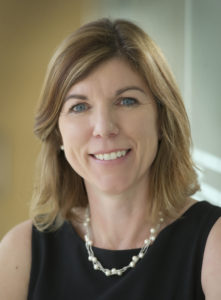January 15, 2024
TORONTO – At THE Myopia Meeting held here Sunday, December 3, 2023, Debbie Jones, BSc(Hons), FCOptom, FAAO, and Jill Woods, MSc, MCOptom, FAAO, presented on behalf of SightGlass Vision. The pair dove deep on the company’s diffusion optics technology (DOT) spectacle lenses for myopia management, highlighting the contrast theory and its link to myopia progression, as well as the latest findings from the company’s CYPRESS trial.
The Contrast Theory
The presentation started with a description of the contrast theory, the ways that it’s thought to be associated with myopia progression, and how that led to the development of the DOT spectacle lenses for myopia management.

Debbie Jones
“If we think about an outside environment, we can call this natural contrast,” Dr. Jones explained. “Basically, we live in an environment of relatively low contrast. Typically, there are shades of browns and greens, and there are not really very many hard and fast, black and white lines, and contrast tends to be quite muted. If you think about our internal environment, and particularly what we’re looking at now with our young patients, and the way they are fixed on near activities, digital devices, reading, homework, and close work, we can refer to that as an artificial contrast environment.
“So, our modern environment has this artificial, very high contrast environment, with a closed field of view. You can compare the outdoor natural contrast and the modern environment, this artificial contrast, and extrapolate that this exposure to an increased amount of this artificial contrast, this near environment, may be a contributing factor to the progression of myopia.”
The Spectacle Design
From there, the discussion transitioned into how the contrast theory affected the design of the DOT spectacle lenses.
“The design of the spectacle is similar to other designs,” Dr. Jones explained. “You have a central clear aperture, and then the rest of the lens has thousands of treatment zones. So, these little dots, micro dots, basically soften and scatter the light to reduce the contrast. It’s not creating blur per se, it’s not an additional positive power – it’s creating a change in contrast. It’s thought that this modulation of the retinal contrast is going to mimic the more natural contrast levels that we see outside.”
To give the audience an idea of what the lens looks like for a patient wearing them, Dr. Jones showed attendees three different images side by side: one of an uncorrected myope’s vision in the classroom, one of a myope wearing single-vision standard correction in the classroom, and one wearing DOT lens correction in the classroom.
“If we have an uncorrected myope, in the classroom, everything at a distance is blurred,” she said. “If we correct that with a standard single vision lens, everything is crisp, clear, and sharp. With the DOT lens, you still get clarity of vision, but you get a gentle softening. Things in the distance have a little bit of a softer focus, but still quite good clarity.”
Dr. Jones then reported on some work that had been presented at the 2023 American Academy of Optometry. The study reported compared two types of visual correction, the DOT spectacle lenses and a standard single vision spectacle lens. The results indicated comparable results for a number of vision measurements (central acuity, peripheral acuity, low contrast, high contrast, and near acuity). She also reported that the same study indicated that contrast sensitivity, glare and halos, reading speed, stereopsis, and color vision were all very comparable across the two optical options between standard single vision and a DOT spectacle lens.
Dr. Jones then handed it over to Dr. Woods to share details of the CYPRESS study. This study, the randomized clinical trial, was designed to look at the safety and efficacy of the DOT lenses. CORE was one of the 14 sites in the U.S. and Canada.
The CYPRESS Trial
From there, Dr. Woods took over to discuss the design of the CYPRESS study and the results that have been collected so far.
“CORE (Centre for Ocular Research and Education) was a site in this study,” Dr. Woods said. “I personally saw a lot of the children’s visits. There were 250 plus children involved in total, and they were younger in age compared to some other myopia randomized trials, which typically start around 7, 8, and go up to 12 years old. We actually involved 6 year olds in this study as well, and I’m going to highlight that in the younger-age data later. The study was designed to be three years, and at the end of the three years, the study was extended for another year.

Jill Woods
“So, just to go through the design, all the children that were eligible to participate were assigned one of three different treatments. There was a control spectacle lens in this study and a test-one and a test-two. We did a quick check in with all the children at one month, and then we saw them six-monthly after that. At the end of the three years, the dropout with test-two was quite a lot higher. Now, that lens design had a denser concentration of those light-diffusing particles. It’s the treatment one that is now commercially available in regions throughout the world, and that’s the data I’m going to concentrate on today. At the end of 36 months, every child was invited to continue for an extra year. So, today I’ll be presenting four-year data. The children in the test product all carried on with test-one, and the children in the control carried on in the control. I’m only going to present the test-one data and the control data.”
Four-Year Data
Dr. Woods then broke down what attendees can expect from the four-year results, including what may have impacted some of the study outcomes.
“Before we get into the results, I do want to highlight one teeny tiny little global event that may have impacted some of the results. You may have heard of it: COVID-19. It was around a couple years ago, maybe still is around,” Dr. Woods said. “One of the things that was instigated in this trial was an extra questionnaire asking the children, are you in full-time school now? Are you at full-time home schooled? Are you doing a bit of a hybrid, part in, part out? The reason that this is thought to be important is that the visual environment for the children and their day-to-day tasks was significantly different during that time period. You’ll see on the graphs, the purple zone shows the percentage of children that were full-time at home for their education. So, there is a significant impact over what may be the best part of 18 months to two years, and that coincided with year two and year three of this study.
“For all the children who completed four years, we have spherical equivalent refraction data and axial length data. After four years, there was a definite efficacy on both of those components, and the graphs are diverging in the first 12 months, as everybody would hope for the myopia control product. Overlaid there is the COVID period, and what’s interesting to note in this period is that the lines remain parallel. The treatment effect is less in that period for sure, but we do see divergence in the first year, and there is divergence in that final fourth year of this data on both refraction and axial length, showing efficacy of treatment.
“I think another important criterion with any myopia treatment that you’re engaging in is to look at the treatment time period. Are we maximizing treatment exposure? Throughout the four years, the children and the families were asked to report how often they wore the treatment. So, now I’m going to present you with the data of those who reported full-time wear. They did not remove the spectacles for reading, and that can be a common practice amongst children wearing spectacles. So, this data now will show you a smaller group. We are down to about 28 or 30 in each of those control and treatment groups. We still have an impact slowing through the COVID years, even though they’ve reported full-time wear, but the efficacy is actually stronger now on both refraction and axial length in the first year and the final year. So again, supporting the fact that the more exposure to treatment you have, the more efficacious that treatment is going to be.”
Looking at Younger-Age Data
From there, Dr. Woods shared some of the data specific to the youngest participants in the trial.
“As I mentioned earlier, one of the key components of this study that might differentiate it from others is that younger age. It’s that younger age that we are more worried about. If 6 and 7 year olds are already myopic, we are worried about how quickly they’re going to progress. So, it’s of interest to look at just that group on its own. Again, these are the children that completed the entire four-year period, and the effect with these children was significantly higher than when we look at the whole group. That’s heartening. It’s showing that the treatment was effective in that younger age group, and there’s very little information out there for the 6 and 7 year olds, so, this is exciting to see.
Then, Dr. Woods wrapped things up, giving attendees a final look at everything that was discussed during the presentation.
“So, just to summarize here and bring everything to a close, as Debbie’s explained, the DOT spectacles are a slightly different, perhaps novel approach. They use contrast reduction, this a slight contrast reduction, as opposed to peripheral blur, for treatment. And the DOT lenses have been shown to be efficacious throughout four years. It’s the first spectacle that’s been shown to be efficacious in that very young 6 to 7 year old. So, that’s encouraging if spectacles are the first option you choose for the younger children in your practice. And the other important point is that even though there is a peripheral treatment zone, the vision, even through that treatment zone, is as good as a regular spectacle lens.”













